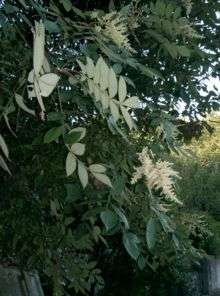Rhus chinensis
| Chinese sumac | |
|---|---|
 | |
| Scientific classification | |
| Kingdom: | Plantae |
| (unranked): | Angiosperms |
| (unranked): | Eudicots |
| (unranked): | Rosids |
| Order: | Sapindales |
| Family: | Anacardiaceae |
| Genus: | Rhus |
| Species: | R. chinensis |
| Binomial name | |
| Rhus chinensis Mill. | |
| Synonyms | |
|
Rhus javanica auct.
| |
Rhus chinensis, the Chinese sumac[1] or nutgall tree, is a plant species in the genus Rhus.
The species is used to produce galls, called Chinese gall, Galla Chinensis or Wu Bei Zi (五倍子) in Chinese, which are rich in gallotannins,[2][3] a type of hydrolysable tannins. The infestation by Chinese sumac aphids (Melaphis chinensis Bell) can lead to a gall which is valued as a commercial product. Chinese galls are used in Chinese medicine to treat coughs, diarrhea, night sweats, dysentery and to stop intestinal and uterine bleeding.[4]
Rhus chinensis compounds possess strong antiviral, antibacterial, anticancer, hepatoprotective, antidiarrheal and antioxidant activities.[5] The gall of Rhus chinensis, Galla chinensi, has long been considered to possess many medicinal properties.[6]
Gallic acid (3,4,5-trihydroxybenzoic acid),isolated from Rhus chinensis, induces apoptosis in human monocytic lymphoma cell line U937 and may be a potential chemotherapeutic agent against lymphoma.[7] The gall of Rhus chinensis inhibits alpha-glucosidase activity.[8]
 foliage
foliage flowers
flowers fruits
fruits Sapling
Sapling
References
- ↑ "Rhus chinensis". Natural Resources Conservation Service PLANTS Database. USDA. Retrieved 21 October 2015.
- ↑ "Identification and structure–activity relationship of gallotannins separated from Galla chinensis". Fang Tian, Bo Lia, Baoping Ji, Guizhi Zhang and Yangchao Luo, LWT - Food Science and Technology, Volume 42, Issue 7, September 2009, Pages 1289-1295 doi:10.1016/j.lwt.2009.03.004
- ↑ "Antioxidant and antimicrobial activities of consecutive extracts from Galla chinensis : The polarity affects the bioactivities". Fang Tian, Bo Lia, Baoping Ji, Jinhua Yang, Guizhi Zhang, Yang Chen and Yangchao Luo, Food Chemistry, Volume 113, Issue 1, 1 March 2009, Pages 173-179 doi:10.1016/j.foodchem.2008.07.062
- ↑ "Aphid", Henry G. Stroyan, McGraw-Hill Encyclopedia of Science and Technology, 8th Edition, 1997, ISBN 0-07-911504-7
- ↑ Djakpo O, Yao W, "Rhus chinensis and Galla Chinensis--folklore to modern evidence: review." Phytother Res. 2010 Dec;24(12):1739-47
- ↑ Zhang J, Li L, Kim SH, Hagerman AE, Lü J. 2009. "Anti-cancer, anti-diabetic and other pharmacologic and biological activities of penta-galloyl-glucose." Pharm Res 26: 2066–2080.
- ↑ Kim NS, Jeong SI, Hwang BS, Lee YE, Kang SH, Lee HC, Oh CH "Gallic acid inhibits cell viability and induces apoptosis in human monocytic cell line U937." J Med Food. 2011 Mar;14(3):240-6
- ↑ Young-Jun Shima, Ho-Kyung Doob, Se-Young Ahnb, Yong-Suk Kimc, Je-Kyung Seongd, In-Sun Parke, Bon-Hong Mina, "Inhibitory effect of aqueous extract from the gall ofRhus chinensis on alpha-glucosidase activity and postprandial blood glucose." Journal of Ethnopharmacology, Volume 85, Issues 2-3, April 2003, Pages 283-287
External links
| Wikispecies has information related to: Rhus chinensis |
| Wikimedia Commons has media related to Rhus chinensis. |
Plants for a Future